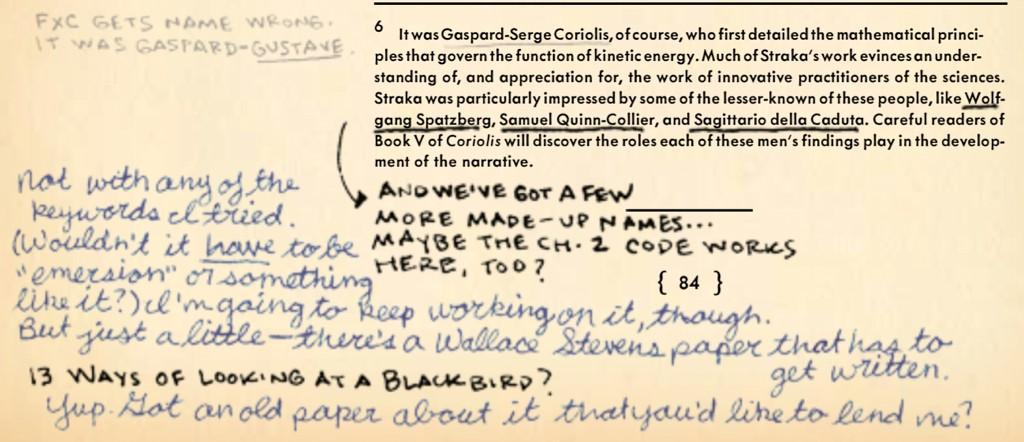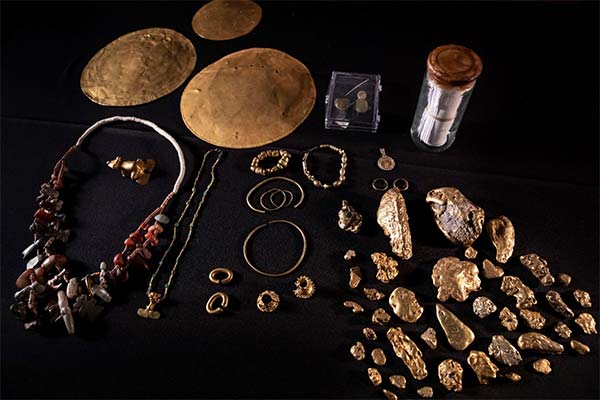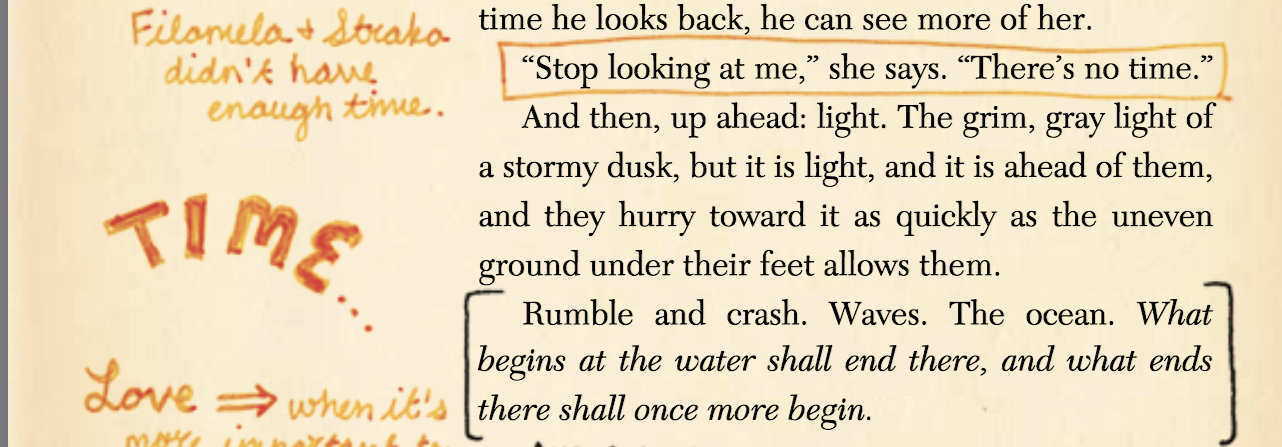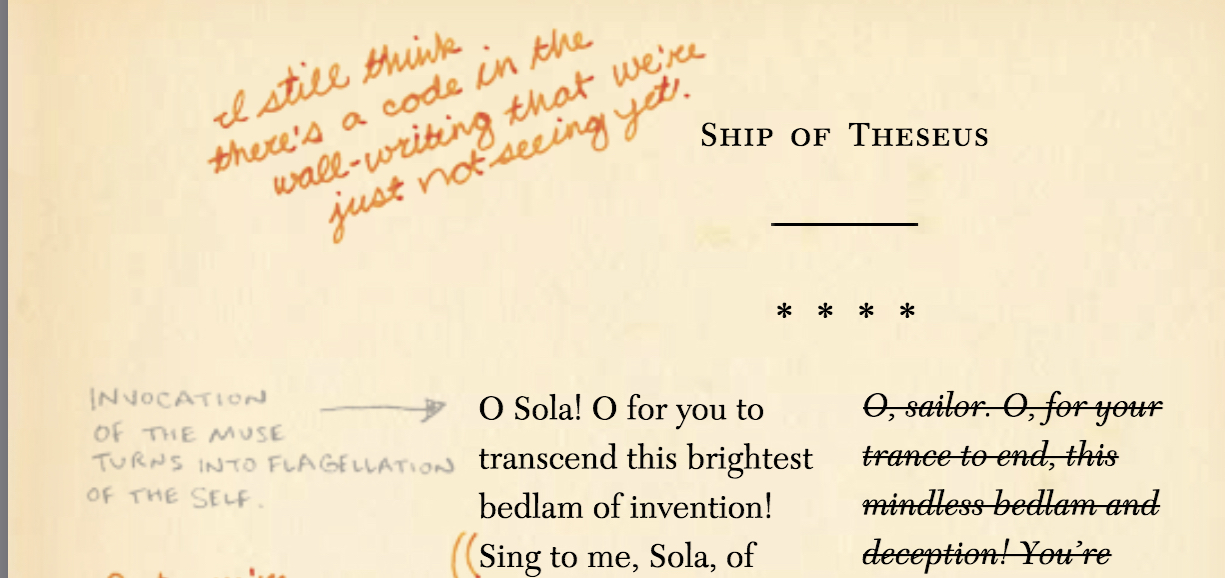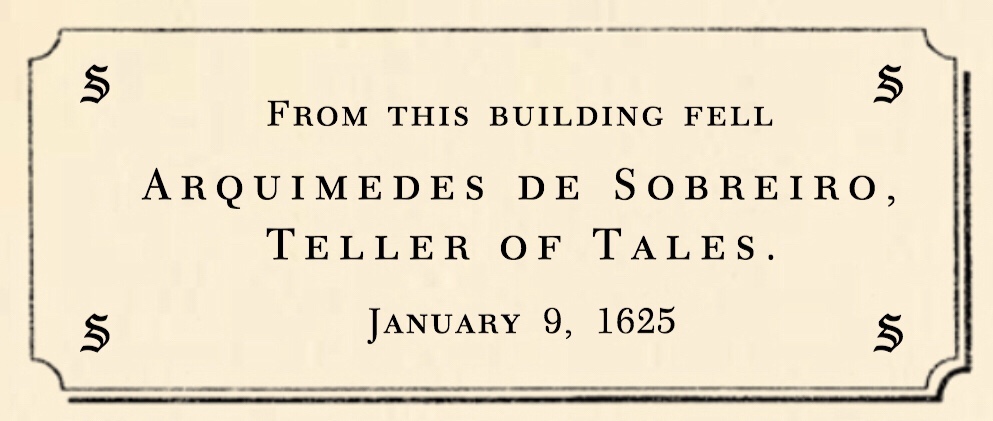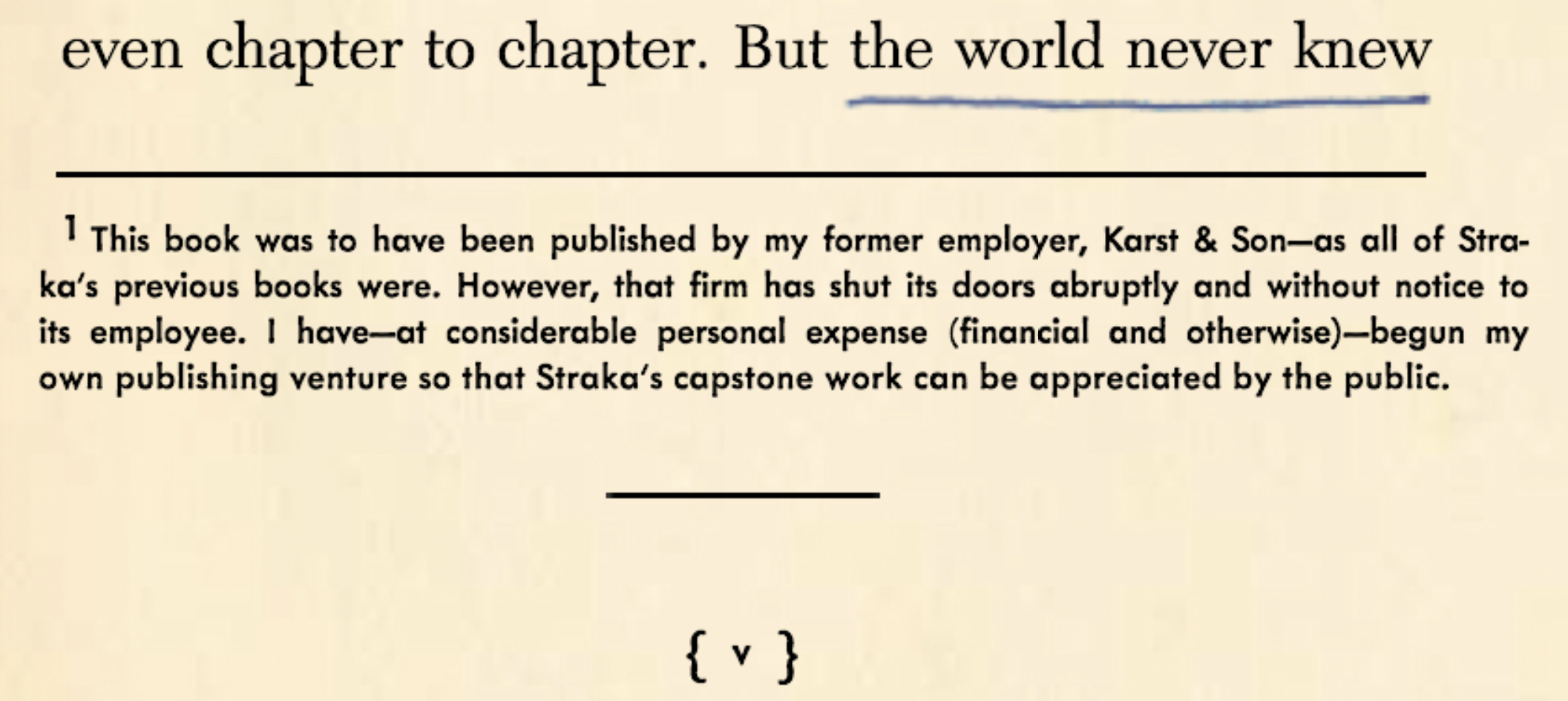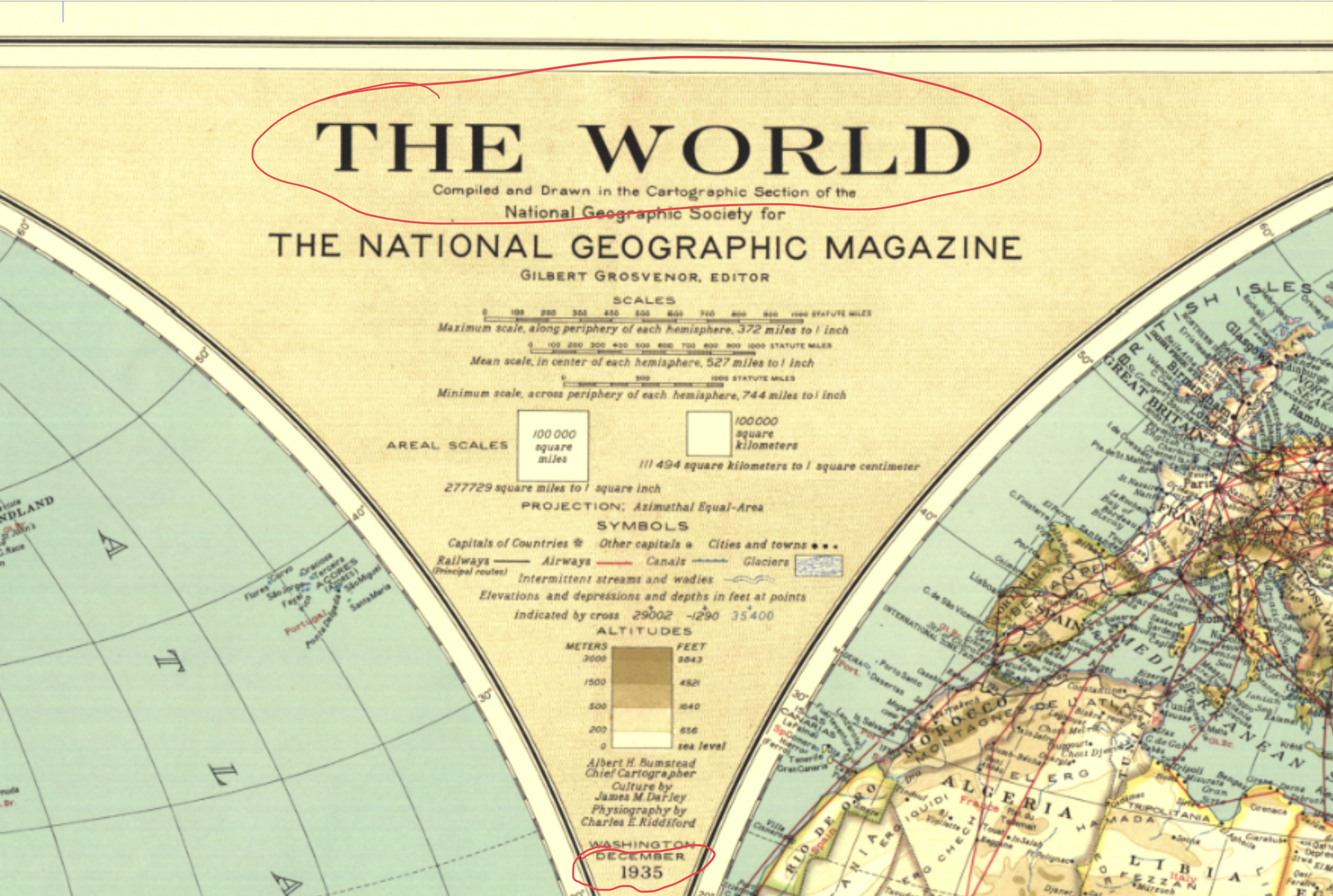One of the over-arching themes in “S” appears to be Boundaries. Seeing them, defining them, approaching them, crossing them – penetrating the territories bounded by them – or connecting two distinct and bounded entities by some important means.
For example, the first word in Chapter 1 is Dusk – the boundary between day and night. The next sentence is simply The Old Quarter of a city where river meets sea. The Old Quarter of this city has boundaries, bordered partially by river and sea.
Are boundaries what are described by the mystery What begins at the water shall end there, and what ends there shall once more begin?
S begins his story at the boundary of his memory and spends most of the story attempting to penetrate it.
The Foreword tells us that Straka was attacked in his Havana hotel room at approximately midnight, the boundary between two days. We also learn that Straka’s publisher is Karst and Son. This is likely a deliberate reference to Jan Carstenszoon, a sailor who in 1623 went in search of a mysterious land in the south. In April of that year, he set foot on what would later be named Australia. This encounter led to the first map of the world to ever show any portion of Australia on it.
On p153, Corbeau takes the time to point out she and her band of fugitives are crossing a line of geological demarcation.
A major point in the story is the discovery of the cave. The entrance to the cave would have been missed had Pfeifer not seen a male chamois roughing its horns on the boulder blocking the entrance from view. Ancient boundary stones often had the symbol of Capricorn, or the sea-goat, etched into them. This symbolism here seems intentional. It’s even more apparent in Pfeifer’s beard – when we first meet him, it is described as a caprine drape – goat-like.
When S and Corbeau leap from the cave’s opposite boundary above the sea, they are holding hands – connected. S hears the gunshots fired at them and compares them to corks flying on a New Year’s Eve – at midnight, the boundary separating one year from the other.
Which brings us back to cork – sobreiro. Cork is the outer shell, or boundary, of the tree and is what seals the wine inside until the time comes to let it escape from the boundary formed by the bottle. The cork is what allows the passage across the boundary.
When S plunges into the ocean, he spooks a school of black scabbard fish. These fish exist only at great depths – far too deep for a human to survive and much deeper than a plunge from the cave would normally take him. Clearly S has crossed an unusual boundary.
Words are a gift to the dead and a warning to the living. Is this a reference to the power of the written word to cross the boundary of death by allowing the words of the dead to live on (their gift) and warn the living of what they learned?
Mercury, the god we see referred to repeatedly in S, is the god of travel and boundaries.
The Charles Bridge connects two land masses separated by the Vltava River in Prague. The book Ship of Theseus connects Jen and Eric, bridging the boundaries that otherwise separated them. The constellations that vanish in The Drifting Twins are created by artificial boundaries drawn in the stars, and S must create new ones.
S’s ship is able to go into some mysterious zone generally protected from penetration by others until Vevoda’s planes make their way through – and at the same time it is symbolized by a map in Maelstrom’s chartroom where blood crosses the boundaries drawn on it. Later, we discover that the monkey sleeps beneath the table that holds the maps and underneath the blanket there is Maelstrom’s spyglass.
The monkey’s connection here to maps and boundaries hearkens back to The Territory, where S begins his trek from the river up to the Governor’s mansion with Anca’s instructions to follow the monkey. After S sees a monkey carved into the face of a tree, he discovers that path that leads him from river to the governor’s garden. And the spyglass – when S looks through it, it seems to cross the boundary from present to a vision of the future.
S is temporarily stranded in The Winter City, and Sola must travel in the ship to reach him. S climbs nine stories to meet her and much is made in the book about him crossing the threshold to the room where she waits. It is Sola who guides him across the threshold then and across the ice later that forms the boundary around the city. During S’s stay there, he finds himself bordered by some mysterious force that allows him to see other people but not interact with them.
Obsidian Island is a mysterious place, where S must enter a cabin atop a volcano to see The Lady and read the book of S. Inside, we see Sobreiro etched onto the hull of the ship. The hull is the boundary of the ship that touches the boundary of the water and allows the two to connect.
Vevoda’s weapon takes off heavily because of war, where countries attempt to protect or expand their boundaries by force.
Sola’s map shows the boundaries of Vevoda’s estate and she and S penetrate that boundary through a cave and a dried up well. The first footnote in chapter 10 (p415) talks about the nebulous boundaries of evil.
Vevoda’s estate is said to be in the foothills of the Pyrenees, the boundary separating Spain and France.
We learn in the marginalia that Signe Rabe married Desjardins in Carcassonne. There is a chapel there that sits on the prime meridian, which separates the eastern and western hemispheres.
And finally, there is the climactic moment of choice. On p432, S begins filling a barrel of wine with poison from a goatskin. Remember, goats are symbols of boundaries. S pauses before completing his task and decides this is not what he wants to do. And so he doesn’t. Rather than kill, he creates levity. And in this moment, S decides he is no longer an assassin. The boundary between one version of S and another is marked by the goatskin bag.
There are many, many other examples in the book that seem to emphasize boundaries and the special things that allow connections to be made across them. It’s possible that the S symbol that S sees throughout the book is always connected to boundaries as well.
The first time S sees the symbol is on the wall of the tavern when he is outside of it. He goes inside, crossing the threshold, and there he meets Sola.
He sees it again when he wakes up the ship, written on the wall that forms the boundary of his room there. Later he writes many, many words all around that room on the wall.
The next sighting is on the wall of the Central Power building as S is chasing Sola and sees the detectives preparing to bomb the wharf, a defining point in the story. It is here that S changes his mind about finding Sola and turns back to wharf to warn his new friends.
S sees two of the symbols on Zapadi’s shutters, the boundary between inside and outside on the window. S notices this as he and Corbeau are holding hands – connecting – and having a discussion about connections.
Then S sees the symbol again the cave, while he is holding Corbeau, painted on the cave wall.
And again on the book in the cabin on Obsidian Island on the spine and cover that binds the book of S together.
The S symbol appears four times on the plaque on the sidewalk in the Winter City that marks the boundary where Sobreiro crossed from death to life after falling nine stories from a window above.
The last time we see the S symbol is on the barrels of wine in Vevoda’s cellar. Those barrels are the boundaries that hold in the wine, and the monkey pulls out the bungs to reconnect the wine to the earth. And perhaps, the S symbol appears on all the wine barrels after S’s decision at the first wine barrel at the entrance to the cellars with the goatskin bag.
The monkey sightings, too, could probably all point to some metaphor of boundary crossings, from the first time we see him as two men attempt to communicate across the boundaries of their separate languages until the last time we see him under the table that holds the maps in the chartroom.
Three times in the book, the phrase full stop is used. In the text, both times refer to Pfeifer’s life being in peril (p190,p362). On p190, S is looking at the last drawing in the cave, the finishes in a downward streak. S comments that this is the last thing Pfeifer will see, full stop. On p362, S contemplates writing a full-stop into Pfeifer’s neck as he lay paralyzed on the ground. And finally, in the marginalia on p455, Jen writes I love you. Full stop. The End. Full stop means – the end, the boundary limit.
Connecting across boundaries is what the written word does, and J.J. Abrams and Doug Dorst said that the S. project is a “love letter to the written word.”
The most poignant view of this in S, other than S and Sola seen together at the end on the ship and Jen and Eric together in Prague is the vision S experiences after the bomb goes off on the wharf. He sees a boy and girl, nearing adulthood, there on the boundary of the wharf next to the ocean. The boy has given the girl a sheaf of papers. She shakes her head in some form of disagreement and hands the papers back, forcefully, and then walks away. S then thinks to himself, “isn’t the point of scenes like this that the two people—two bodies, two souls—come together?”
It is the point. And the writing on the papers was intended to accomplish that connection, but in this case it did not. Etymological roots for sheaf (as in the papers) and boundary seem to converge.
Particular interesting is that the latin root mergae, meaning sheaf, is connected to marg-o/margen, which means boundary. It is where we get the word margin – where all of our knowledge of Jen and Eric springs!
This theme of boundaries along with the Ship of Theseus idea leads straight into the heart of a unifying theme, at least in my opinion, called autopoiesis and structural coupling. But that is another blog entry entirely.
